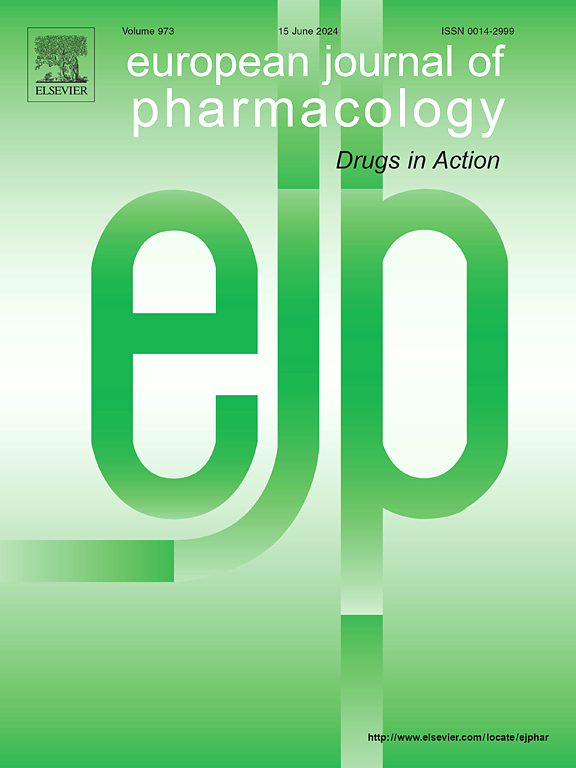二氢杨梅素通过靶向SRC-MAPK信号通路恢复COPD患者气液界面培养液的粘液分泌
IF 4.2
3区 医学
Q1 PHARMACOLOGY & PHARMACY
引用次数: 0
摘要
慢性阻塞性肺疾病(COPD)是一种异质性疾病,以支气管炎和肺气肿引起的慢性呼吸道症状为特征,常导致持续性气流阻塞。黄藤提取物二氢杨梅素(DHM)具有抗炎、抗肿瘤和抗氧化作用,对体内外正常细胞无明显毒性。本研究旨在探讨丹参对慢性阻塞性肺病(COPD)患者气液界面(ALI)粘液分泌增高的影响,并探讨其作用机制。在ALI通过支气管镜收集了5名COPD患者和5名非COPD患者的支气管上皮细胞。COPD和非COPD受试者的ALI培养物以及气道类器官分化2周,随后再用DHM (50 μM)治疗2周。利用网络药理学分析和分子对接技术对DHM的潜在分子机制进行了研究。DHM减少ALI培养的粘液分泌增多,增加纤毛数量(平均倍数变化= 6.52,P = 0.0033;平均折线变化= 11.56,P = 0.0011)和气道类器官(平均折线变化= 1.68,P = 0.0096;平均折叠变化= 1.60,P = 0.0130)。网络药理学分析在实验验证的支持下,证实DHM通过与SRC结合,调节自噬相关蛋白和MAPK信号通路,缓解copd相关黏液高分泌,改善纤毛形态。这些发现提示DHM可能是预防慢性阻塞性肺病粘液分泌过多的潜在治疗剂。本研究首次结合网络药理学分析探讨DHM缓解copd相关粘液分泌增高的机制。本文章由计算机程序翻译,如有差异,请以英文原文为准。
Dihydromyricetin restores mucus hypersecretion in Air–Liquid interface cultures in COPD by targeting the SRC-MAPK signaling pathway
Chronic obstructive pulmonary disease (COPD) is a heterogeneous condition characterized by chronic respiratory symptoms due to bronchitis and emphysema, often leading to persistent airflow obstruction. Dihydromyricetin (DHM), a Garcinia cambogia extract, exhibited anti-inflammatory, antitumor, and antioxidant effects without significant toxicity to normal cells in vitro and in vivo. This study aimed to investigate the effect of DHM on mucus hypersecretion in air–liquid interface (ALI) cultures in COPD and to explore the underlying mechanism. Bronchial epithelial cells from five COPD patients and five Non-COPD subjects were collected by bronchoscopy at ALI. ALI cultures from COPD and Non-COPD subjects, as well as airway organoids, were differentiated for 2 weeks subsequently treated with DHM (50 μM) for an additional 2 weeks. The potential molecular mechanisms of DHM were investigated using network pharmacology analysis and molecular docking techniques. DHM reduced mucus hypersecretion and increased cilia number in ALI cultures (Average fold change = 6.52, P = 0.0033; average fold change = 11.56, P = 0.0011) and airway organoids (average fold change = 1.68, P = 0.0096; average fold change = 1.60, P = 0.0130) from COPD patients. Network pharmacology analysis, supported by experimental validation, confirmed that DHM alleviated COPD-related mucus hypersecretion and improved ciliary morphology by binding to SRC and regulating autophagy-related proteins and the MAPK signaling pathway. These findings suggest that DHM could be a potential therapeutic agent for preventing mucus hypersecretion in COPD. This study is the first to combine network pharmacology analysis to investigate the mechanism of DHM in alleviating COPD-associated mucus hypersecretion.
求助全文
通过发布文献求助,成功后即可免费获取论文全文。
去求助
来源期刊
CiteScore
9.00
自引率
0.00%
发文量
572
审稿时长
34 days
期刊介绍:
The European Journal of Pharmacology publishes research papers covering all aspects of experimental pharmacology with focus on the mechanism of action of structurally identified compounds affecting biological systems.
The scope includes:
Behavioural pharmacology
Neuropharmacology and analgesia
Cardiovascular pharmacology
Pulmonary, gastrointestinal and urogenital pharmacology
Endocrine pharmacology
Immunopharmacology and inflammation
Molecular and cellular pharmacology
Regenerative pharmacology
Biologicals and biotherapeutics
Translational pharmacology
Nutriceutical pharmacology.

 求助内容:
求助内容: 应助结果提醒方式:
应助结果提醒方式:


